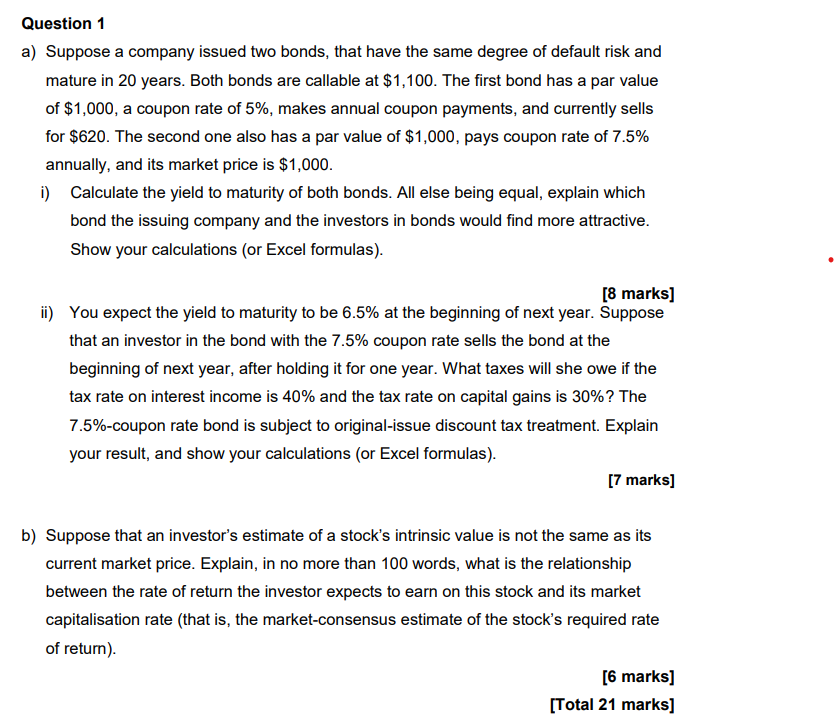
Question 1 a) Suppose a company issued two bonds, that have the same degree of default risk and mature in 20 years. Both bonds are callable at $1,100. The first bond has a par value of $1,000, a coupon rate of 5%, makes annual coupon payments, and currently sells for $620. The second one also has a par value of $1,000, pays coupon rate of 7.5% annually, and its market price is $1,000. i) Calculate the yield to maturity of both bonds. All else being equal, explain which bond the issuing company and the investors in bonds would find more attractive. Show your calculations (or Excel formulas). [8 marks] ii) You expect the yield to maturity to be 6.5% at the beginning of next year. Suppose that an investor in the bond with the 7.5% coupon rate sells the bond at the beginning of next year, after holding it for one year. What taxes will she owe if the tax rate on interest income is 40% and the tax rate on capital gains is 30%? The 7.5%-coupon rate bond is subject to original-issue discount tax treatment. Explain your result, and show your calculations (or Excel formulas). [7 marks] b) Suppose that an investor's estimate of a stock's intrinsic value is not the same as its current market price. Explain, in no more than 100 words, what is the relationship between the rate of return the investor expects to earn on this stock and its market capitalisation rate (that is, the market-consensus estimate of the stock's required rate of return) [6 marks] [Total 21 marks] Question 1 a) Suppose a company issued two bonds, that have the same degree of default risk and mature in 20 years. Both bonds are callable at $1,100. The first bond has a par value of $1,000, a coupon rate of 5%, makes annual coupon payments, and currently sells for $620. The second one also has a par value of $1,000, pays coupon rate of 7.5% annually, and its market price is $1,000. i) Calculate the yield to maturity of both bonds. All else being equal, explain which bond the issuing company and the investors in bonds would find more attractive. Show your calculations (or Excel formulas). [8 marks] ii) You expect the yield to maturity to be 6.5% at the beginning of next year. Suppose that an investor in the bond with the 7.5% coupon rate sells the bond at the beginning of next year, after holding it for one year. What taxes will she owe if the tax rate on interest income is 40% and the tax rate on capital gains is 30%? The 7.5%-coupon rate bond is subject to original-issue discount tax treatment. Explain your result, and show your calculations (or Excel formulas). [7 marks] b) Suppose that an investor's estimate of a stock's intrinsic value is not the same as its current market price. Explain, in no more than 100 words, what is the relationship between the rate of return the investor expects to earn on this stock and its market capitalisation rate (that is, the market-consensus estimate of the stock's required rate of return) [6 marks] [Total 21 marks]







